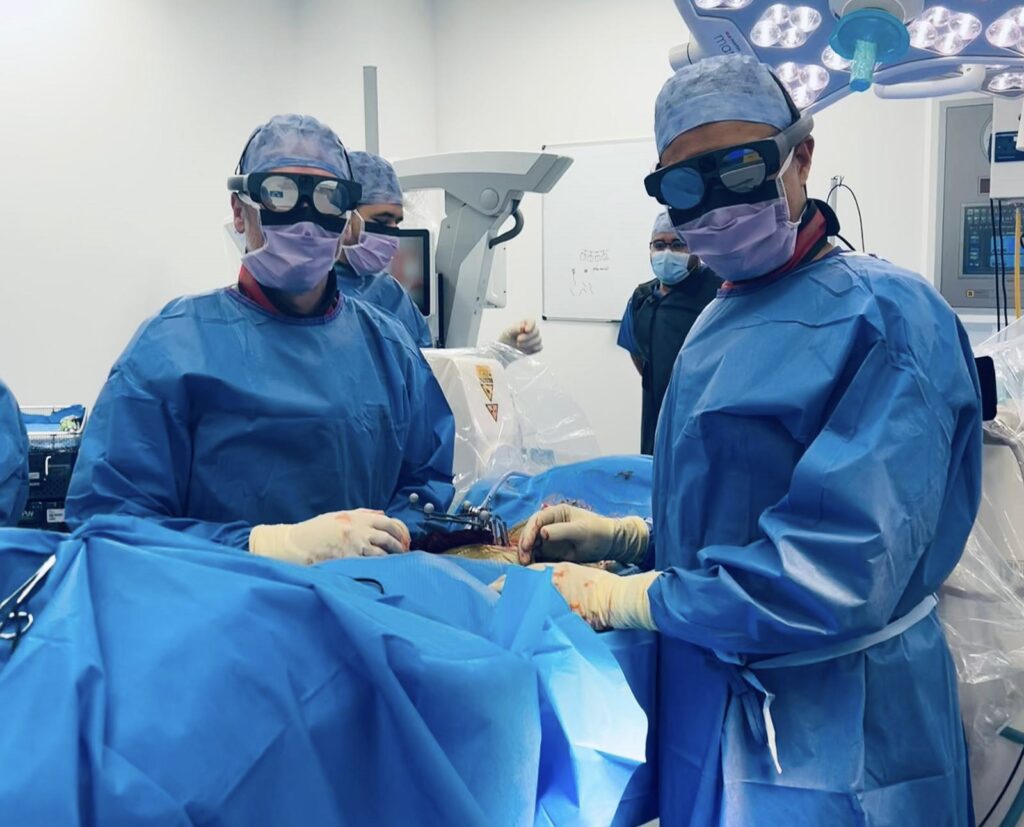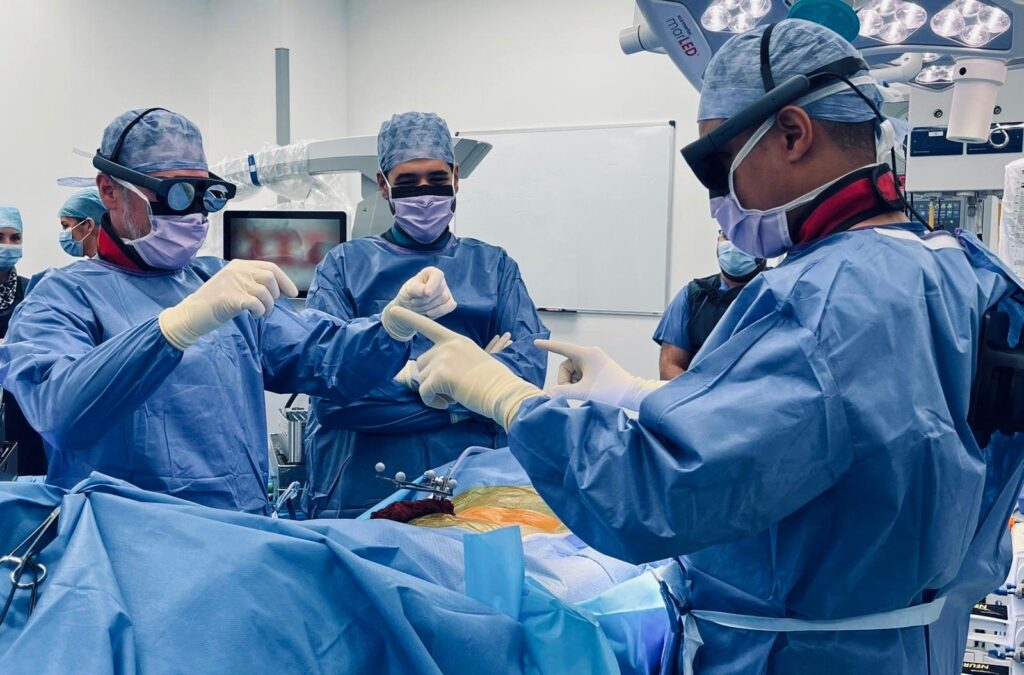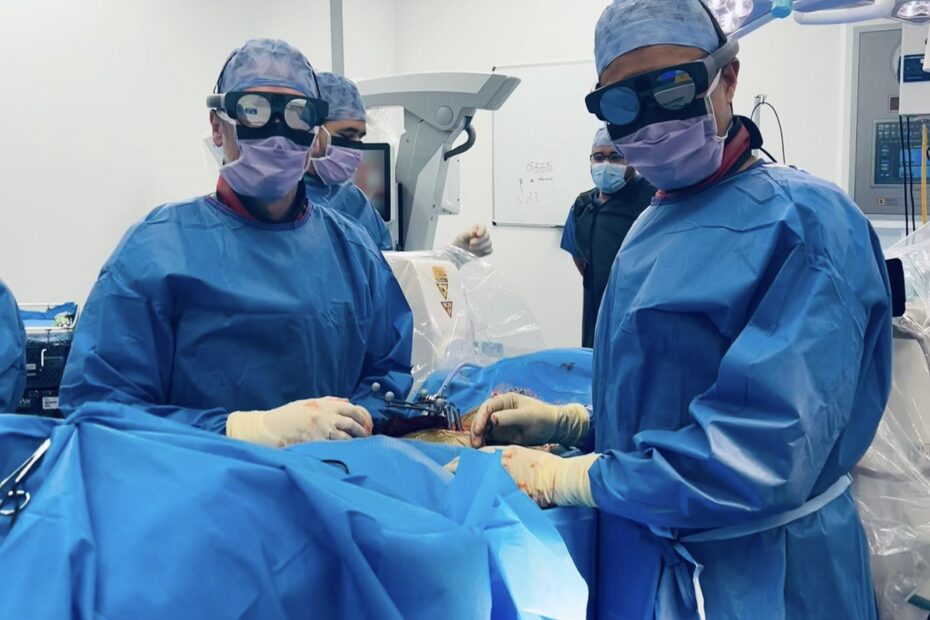
The Institute for Neurological Sciences in Glasgow has performed the first operation in the UK – and is only the third centre worldwide – that uses Mixed Reality (MR) technology to allow the surgeon to “see inside” a patient’s body during surgery.
The Institute is operated by NHS Greater Glasgow and Clyde providing highly specialised care for patients throughout Scotland – and the fact the MR procedure took place there cements its place as an international centre of excellence and innovation.
The major operation involved surgery on 75-year-old Carol Toal to correct a misalignment of her spine, treat a spinal cyst and decompress spinal nerves.
The issue had left Mrs Toal, from Irvine, with chronic pain in her back and leg and meant the formerly active woman struggled to walk more than 25 yards without having to stop.
The procedure earlier this month involved a highly advanced system called Spine Mixed Reality Navigation, as part of a trial in conjunction with manufacturer Brainlab.
The system takes current technology which fuses intraoperative X-rays with external images of a patient and, instead of a surgeon needing to look at a screen the images are relayed through MR goggles, giving an extremely accurate view of the patient’s body and their underlying spinal anatomy.
Mohamed Abdelsadg, Consultant Neurosurgeon and Complex Spine Surgeon, carried out the surgery. He said: “The result is we are effectively able to see inside a patient’s body while we are performing the operation.
“This means the surgery is much more accurate, is much less invasive, and minimises surgical damage to other tissue.”

For Mr Abdelsadg and his team, the operation went very smoothly – largely down to the amount of preparation the team were able to do.
He said: “We already do a lot of minimally invasive work using an earlier Brainlab system, so we were familiar with the set-up and this felt more like a software upgrade rather than a completely new system.
“Also, the spinal neurosurgeons arranged for three days’ training in the Institute’s Teasdale simulation suite, which allowed us to familiarise ourselves with the kit. This meant the technical part of the operation went well.”
Less than a week after the operation, Mr Abdelsadg said Mrs Toal’s leg pain was resolved and, while she was experiencing some back pain due to the surgery, it is expected that will reduce with time.
Mrs Toal herself was happy with how the surgery went, and she felt she was recovering well.
She said: “My leg is much better and though I still have some pain in my back I’m feeling really hopeful.
“Before the pain got too bad, I used to be really active, going swimming, taking lots of holidays with my husband Robert and spending time with our six grandchildren, so I’m really looking forward to being able to do more in future.
“I’d just like to say thank you to everyone who’s been involved in my care. I can’t praise them highly enough – in fact the surgeon and his team really have been lifesavers for me.”
While Mrs Toal was the first patient to undergo surgery using the Spine Mixed Reality system, the team hope her positive progress means it won’t be the last.
“Our early experience was certainly positive,” said Mr Abdelsadg, “and we all feel this system has real potential to build on the advanced neurosurgical work we do at the Institute.”
Susan Groom, Director of Regional Services at NHS Greater Glasgow and Clyde, said: “The Institute for Neurological Sciences, and services across NHS Greater Glasgow and Clyde, are always looking to embrace innovations that are shown to improve outcomes for our patients.
“I would like to thank the team at the Institute for their work during the trial, and express my appreciation to Brainlab for coming to us with this new equipment.
“Being the first centre in the UK, and only the third in the world, to use this mixed reality technology is a further demonstration of the high regard internationally in which the Institute is held.”

